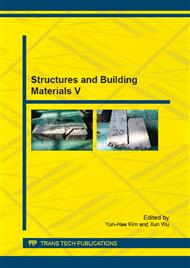p.8
p.13
p.18
p.23
p.27
p.34
p.38
p.42
p.48
Experimental Research on Anti-Seismic Performance of the Plane Steel Frame Beam-Column Joints
Abstract:
The force performance of semi-rigid nodes connection between rigid connection and hinged connection ,which has very high strength and rigidity, good ductility and energy dissipation capacity. At present, it is one of the hot topics in the study of steel structure. This article will study about type T and cross-shaped frame plane frame node characteristics by some experiments. And we will observe the deflection of the two kinds of nodes, the force transmission mechanism and the failure pattern under low reversed cyclic loading test.And then compare the failure mechanism of failure mode and ultimate deformation state and hysteretic performance of the two kinds of nodes, The test results show that the yield load and the yield displacement and energy dissipation coefficient and the equivalent viscous damping ratio of Cross nodes are all greater than type T nodes’. So in the design of steel structure, increasing the component’s constraint can help to improve the seismic performance and stability of the whole structure.
Info:
Periodical:
Pages:
27-33
Citation:
Online since:
July 2015
Authors:
Price:
Сopyright:
© 2015 Trans Tech Publications Ltd. All Rights Reserved
Share:
Citation:


